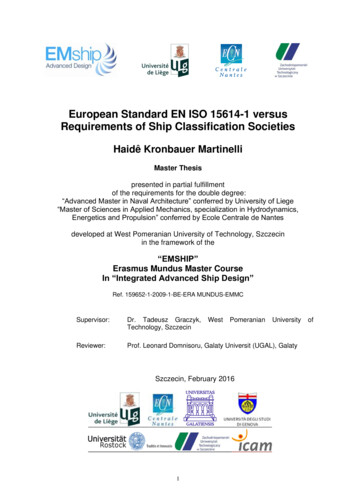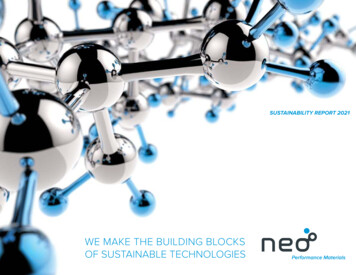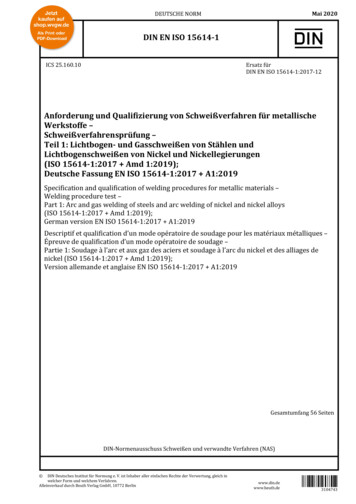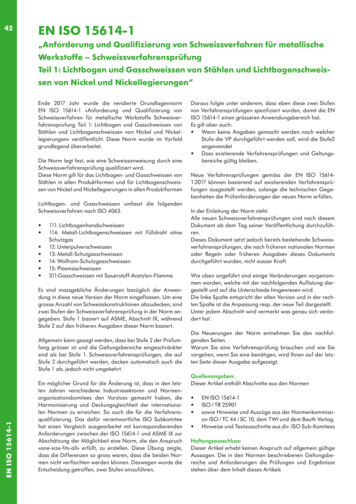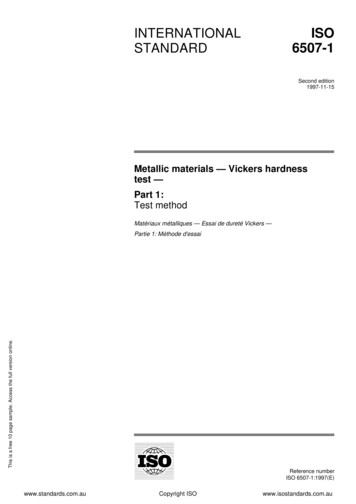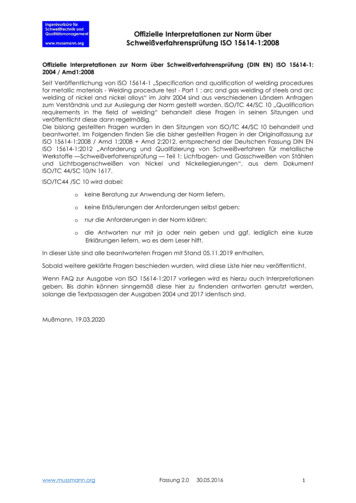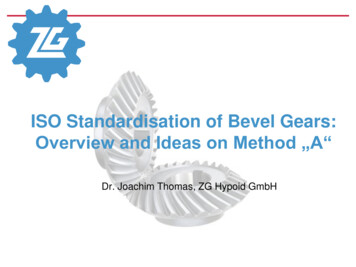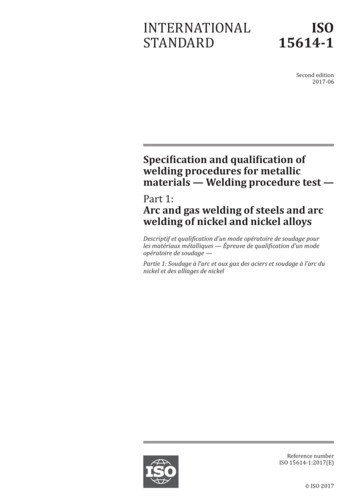
Transcription
INTERNATIONALSTANDARDISO15614-1Second edition2017-06Specification and qualification ofwelding procedures for metallicmaterials — Welding procedure test —Part 1:Arc and gas welding of steels and arcwelding of nickel and nickel alloysDescriptif et qualification d’un mode opératoire de soudage pourles matériaux métalliques — Épreuve de qualification d’un modeopératoire de soudage —Partie 1: Soudage à l’arc et aux gaz des aciers et soudage à l’arc dunickel et des alliages de nickelReference numberISO 15614-1:2017(E) ISO 2017
ISO 15614-1:2017(E)COPYRIGHT PROTECTED DOCUMENT ISO 2017, Published in SwitzerlandAll rights reserved. Unless otherwise specified, no part of this publication may be reproduced or utilized otherwise in any formor by any means, electronic or mechanical, including photocopying, or posting on the internet or an intranet, without priorwritten permission. Permission can be requested from either ISO at the address below or ISO’s member body in the country ofthe requester.ISO copyright officeCh. de Blandonnet 8 CP 401CH-1214 Vernier, Geneva, SwitzerlandTel. 41 22 749 01 11Fax 41 22 749 09 47copyright@iso.orgwww.iso.orgii ISO 2017 – All rights reserved
ISO 15614-1:2017(E)Contents PageForeword.vIntroduction. vi12345678Scope. 1Normative references. 2Terms and definitions. 3Preliminary welding procedure specification (pWPS). 3Welding procedure test. 3Test piece. 36.1General. 36.2Shape and dimensions of test pieces. 46.2.1General. 46.2.2Butt joint in plate with full penetration. 46.2.3Butt joint in pipe with full penetration. 46.2.4T-joint. 46.2.5Branch connection. 46.3Welding of test pieces. 4Examination and testing. 87.1Type and extent of testing. 87.2Location and taking of test specimens. 97.3Non-destructive testing. 137.4Destructive testing. 137.4.1Transverse tensile test. 137.4.2Bend test. 137.4.3Macroscopic examination. 137.4.4Impact testing. 147.4.5Hardness testing. 147.5Acceptance levels. 157.6Re-testing. 16Range of qualification.168.1General. 168.2Related to the manufacturer. 168.3Related to the parent material. 178.3.1Parent material grouping. 178.3.2Material thickness. 198.3.3Diameter of pipes and branch connections. 218.3.4Angle of branch connection. 218.4Common to all welding procedures. 228.4.1Welding processes. 228.4.2Welding positions. 228.4.3Type of joint/weld. 238.4.4Filler material, manufacturer/trade name, designation. 248.4.5Filler material size. 248.4.6Type of current. 258.4.7Heat input (arc energy). 258.4.8Preheat temperature. 258.4.9Interpass temperature. 258.4.10 Post-heating for hydrogen release. 268.4.11 Heat-treatment. 268.5Specific to processes. 268.5.1Submerged arc welding (process 12). 268.5.2Gas-shielded metal arc welding (process 13). 27 ISO 2017 – All rights reserved iii
ISO 15614-1:2017(E)98.5.38.5.48.5.58.5.6Gas-shielded arc welding with non-consumable electrode (process 14). 29Plasma arc welding (process 15). 29Oxy-acetylene welding (process 311). 29Backing gas. 29Welding procedure qualification record (WPQR).29Annex A (normative) Filler material, designation.31Annex B (informative) Welding procedure qualification record form (WPQR).33Bibliography. 38iv ISO 2017 – All rights reserved
ISO 15614-1:2017(E)ForewordISO (the International Organization for Standardization) is a worldwide federation of national standardsbodies (ISO member bodies). The work of preparing International Standards is normally carried outthrough ISO technical committees. Each member body interested in a subject for which a technicalcommittee has been established has the right to be represented on that committee. Internationalorganizations, governmental and non-governmental, in liaison with ISO, also take part in the work.ISO collaborates closely with the International Electrotechnical Commission (IEC) on all matters ofelectrotechnical standardization.The procedures used to develop this document and those intended for its further maintenance aredescribed in the ISO/IEC Directives, Part 1. In particular the different approval criteria needed for thedifferent types of ISO documents should be noted. This document was drafted in accordance with theeditorial rules of the ISO/IEC Directives, Part 2 (see www .iso .org/ directives).Attention is drawn to the possibility that some of the elements of this document may be the subject ofpatent rights. ISO shall not be held responsible for identifying any or all such patent rights. Details ofany patent rights identified during the development of the document will be in the Introduction and/oron the ISO list of patent declarations received (see www .iso .org/ patents).Any trade name used in this document is information given for the convenience of users and does notconstitute an endorsement.For an explanation on the voluntary nature of standards, the meaning of ISO specific terms andexpressions related to conformity assessment, as well as information about ISO’s adherence to theWorld Trade Organization (WTO) principles in the Technical Barriers to Trade (TBT) see the followingURL: www .iso .org/ iso/ foreword .html.This document was prepared by Technical Committee ISO/TC 44, Welding and allied processes,Subcommittee SC 10, Quality management in the field of welding.This second edition cancels and replaces the first edition (ISO 15614-1:2004), which has beentechnically revised. It also incorporates the Amendments ISO 15614-1:2004/Amd 1:2008 andISO 15614-1:2004/Amd 2:2012 and the Technical Corrigendum ISO 15614-1:2004/Cor. 1:2005.A list of all parts in the ISO 15614 series can be found on the ISO website.Requests for official interpretations of any aspect of this document should be directed to the Secretariatof ISO/TC 44/SC 10 via your national standards body. A complete listing of these bodies can be found atwww .iso .org. ISO 2017 – All rights reserved v
ISO 15614-1:2017(E)IntroductionAll new welding procedure tests are to be carried out in accordance with this document from the dateof its issue. However, this document does not invalidate previous welding procedure tests made toformer national standards or specifications or previous issues of this document.Two levels of welding procedure tests are given in order to permit application to a wide range of weldedfabrication. They are designated by levels 1 and 2.Level 1 is based on requirements of ASME Section IX and level 2 is based on the previous issues of thisdocument.vi ISO 2017 – All rights reserved
INTERNATIONAL STANDARD ISO 15614-1:2017(E)Specification and qualification of welding procedures formetallic materials — Welding procedure test —Part 1:Arc and gas welding of steels and arc welding of nickel andnickel alloys1 ScopeThis document specifies how a preliminary welding procedure specification is qualified by weldingprocedure tests.This document applies to production welding, repair welding and build-up welding.This document defines the conditions for the execution of welding procedure tests and the range ofqualification for welding procedures for all practical welding operations within the qualification of thisdocument.The primary purpose of welding procedure qualification is to demonstrate that the joining processproposed for construction is capable of producing joints having the required mechanical properties forthe intended application.Two levels of welding procedure tests are given in order to permit application to a wide range of weldedfabrication. They are designated by levels 1 and 2. In level 2, the extent of testing is greater and theranges of qualification are more restrictive than in level 1.Procedure tests carried out to level 2 automatically qualify for level 1 requirements, but not vice-versa.When no level is specified in a contract or application standard, all the requirements of level 2 apply.This document applies to the arc and gas welding of steels in all product forms and the arc welding ofnickel and nickel alloys in all product forms.Arc and gas welding are covered by the following processes in accordance with ISO 4063.111 — manual metal arc welding (metal-arc welding with covered electrode);114 — self-shielded tubular-cored arc welding;12 — submerged arc welding;13 — gas-shielded metal arc welding;14 — gas-shielded arc welding with non-consumable electrode;15 — plasma arc welding;311 — oxy-acetylene welding.The principles of this document may be applied to other fusion welding processes.NOTEA former process number does not require a new qualification test according to this document.Specification and qualification of welding procedures that were made in accordance with previouseditions of this document may be used for any application for which the current edition is specified. Inthis case, the ranges of qualification of previous editions remain applicable. ISO 2017 – All rights reserved 1
ISO 15614-1:2017(E)It is also possible to create a new WPQR (welding procedure qualification record) range of qualificationaccording to this edition based on the existing qualified WPQR, provided the technical intent of thetesting requirements of this document has been satisfied. Where additional tests have to be carried outto make the qualification technically equivalent, it is only necessary to perform the additional test on atest piece.2 Normative referencesThe following documents are referred to in the text in such a way that some or all of their contentconstitutes requirements of this document. For dated references, only the edition cited applies. Forundated references, the latest edition of the referenced document (including any amendments) applies.ISO 148-1, Metallic materials — Charpy pendulum impact test — Part 1: Test methodISO 3452-1, Non-destructive testing — Penetrant testing — Part 1: General principlesISO 4063, Welding and allied processes — Nomenclature of processes and reference numbersISO 4136, Destructive tests on welds in metallic materials — Transverse tensile testISO 5173, Destructive tests on welds in metallic materials — Bend testsISO 5817, Welding — Fusion-welded joints in steel, nickel, titanium and their alloys (beam weldingexcluded) — Quality levels for imperfectionsISO 6520-1, Welding and allied processes — Classification of geometric imperfections in metallicmaterials — Part 1: Fusion weldingISO 6947, Welding and allied processes — Welding positionsISO 9015-1, Destructive tests on welds in metallic materials — Hardness testing — Part 1: Hardness test onarc welded jointsISO 9016, Destructive tests on welds in metallic materials — Impact tests — Test specimen location, notchorientation and examinationISO 14175, Welding consumables — Gases and gas mixtures for fusion welding and allied processesISO 15609-1, Specification and qualification of welding procedures for metallic materials — Weldingprocedure specification — Part 1: Arc weldingISO 15609-2, Specification and qualification of welding procedures for metallic materials — Weldingprocedure specification — Part 2: Gas weldingISO 15613, Specification and qualification of welding procedures for metallic materials — Qualificationbased on pre-production welding testISO 17636-1, Non-destructive testing of welds — Radiographic testing — Part 1: X- and gamma-raytechniques with filmISO 17636-2, Non-destructive testing of welds — Radiographic testing — Part 2: X- and gamma-raytechniques with digital detectorsISO 17637, Non-destructive testing of welds — Visual testing of fusion-welded jointsISO 17638, Non-destructive testing of welds — Magnetic particle testingISO 17639, Destructive tests on welds in metallic materials — Macroscopic and microscopic examinationof weldsISO 17640, Non-destructive testing of welds — Ultrasonic testing — Techniques, testing levels, andassessment2 ISO 2017 – All rights reserved
ISO 15614-1:2017(E)ISO/TR 15608, Welding — Guidelines for a metallic materials grouping systemISO/TR 17671-1, Welding — Recommendations for welding of metallic materials — Part 1: Generalguidance for arc weldingISO/TR 18491, Welding and allied processes — Guidelines for measurement of welding energiesISO/TR 20172, Welding — Grouping systems for materials — European materialsISO/TR 20173, Welding — Grouping systems for materials — American materialsISO/TR 20174, Welding — Grouping systems for materials — Japanese materialsISO/TR 25901 (all parts), Welding and allied processes — Vocabulary3 Terms and definitionsFor the purposes of this document, the terms and definitions given in ISO/TR 25901 (all parts) and thefollowing apply.ISO and IEC maintain terminological databases for use in standardization at the following addresses:— ISO Online browsing platform: available at http:// w ww .iso .org/ obp— IEC Electropedia: available at http:// w ww .electropedia .org/ 3.1run out lengthlength of a run produced by the melting of a covered electrodeNote 1 to entry: See ISO/TR 17671-2.3.2build-up weldingaddition of weld metal to obtain or restore required dimensions4 Preliminary welding procedure specification (pWPS)The preliminary welding procedure specification shall be prepared in accordance with ISO 15609-1 orISO 15609-2.5 Welding procedure testThe welding and testing of test pieces shall be in accordance with Clauses 6 and 7.The welder or welding operator who undertakes the welding procedure test satisfactorily in accordancewith this document is qualified according to the relevant national/international standard being applied,provided that the relevant testing requirements of that standard are met.6 Test piece6.1 GeneralThe welded joint to which the welding procedure will relate in production shall be represented bymaking a standard test piece or pieces, as specified in 6.2.If required by the application standard, the direction of plate rolling shall be marked on the test piecewhen impact tests are required to be taken in the Heat Affected Zone (HAZ) and shall be mentioned inthe impact test report. ISO 2017 – All rights reserved 3
ISO 15614-1:2017(E)For level 1: Any butt joint test qualifies all jointconfigurations.6.2 Shape and dimensions of test pieces6.2.1For level 2: Where the joint requirements and/ordimension of the test piece are not covered by thestandard test pieces as shown in this document,the use of ISO 15613 shall be required.GeneralThe length or number of test pieces shall be sufficient to allow all required tests to be carried out.Additional test pieces, or longer test pieces than the minimum size, may be prepared in order to allowfor extra testing and/or for re-testing specimens (see 7.6).For all test pieces except branch connections (see Figure 4) and T-joints (T-butt weld or fillet weld; seeFigure 3), the material thickness, t, and the diameter, D, shall be the same for both plates and pipes onthe required length of the test piece to be welded.The thickness and/or pipe outside diameter of the test pieces shall be selected in accordance with 8.3.2to 8.3.3.6.2.2Butt joint in plate with full penetrationThe test piece shall be prepared in accordance with Figure 1.6.2.3Butt joint in pipe with full penetrationThe test piece shall be prepared in accordance with Figure 2.NOTEThe word “pipe”, alone or in combination, is used to mean “pipe”, “tube” or “hollow section” exceptsquare or rectangular hollow section.6.2.4T-jointThe test piece shall be prepared in accordance with Figure 3. This test piece applies to fully penetratedbutt welds or fillet welds.6.2.5Branch connectionFor level 1: No specific test piece required.6.3 Welding of test piecesFor level 2: The test piece shall be prepared inaccordance with Figure 4. The angle α is theminimum one used in production. This test pieceapplies to fully penetrated joints (set-on, set-in orset-through joint) and for fillet welds.Preparation and welding of test pieces shall be carried out in accordance with the pWPS, which theyshall represent. Welding positions and limitations for the angle of slope and rotation of the test pieceshall be in accordance with ISO 6947. If tack welds are to be fused into the final joint, they shall beincluded in the test piece.The welding and the testing of the test piece shall be verified by the examiner or examining body.4 ISO 2017 – All rights reserved
ISO 15614-1:2017(E)Key1 joint preparation and fit-up as detailed in the preliminary welding procedure specification (pWPS)a minimum dimension 150 mmb minimum dimension 350 mmtmaterial thicknessFigure 1 — Test piece for a butt joint in plate with full penetrationKey1 joint preparation and fit-up as detailed in the preliminary welding procedure specification (pWPS)a minimum dimension 150 mmD outside pipe diametertmaterial thicknessFigure 2 — Test piece for a butt joint in pipe with full penetration ISO 2017 – All rights reserved 5
ISO 15614-1:2017(E)Key1abt1, t26 joint preparation and fit-up as detailed in the preliminary welding procedure specification (pWPS)minimum dimension 150 mmminimum dimension 350 mmmaterial thicknessFigure 3 — Test piece for a T-joint ISO 2017 – All rights reserved
ISO 15614-1:2017(E)Key1 joint preparation and fit-up as detailed in the preliminary welding procedure specification (pWPS)α branch anglea minimum dimension 150 mmD1 outside diameter of main pipeD2 outside diameter of branch pipet1 main pipe material thicknesst2 branch pipe material thicknessFigure 4 — Test piece for a branch connection ISO 2017 – All rights reserved 7
ISO 15614-1:2017(E)7 Examination and testing7.1 Type and extent of testingFor level 1: Type and the extent of testing shall be For level 2: Type and the extent of testing shall bein accordance with the requirements of Table 1.in accordance with the requirements of Table 2.If impact testing, hardness testing or non-destructive testing (NDT) is required by an applicationstandard or specification, they shall be carried outand assessed in accordance with the requirementsof level 2, unless otherwise specified by the application standard or specification.An application standard may specify additional tests, e.g.:— longitudinal weld tensile test;— all weld metal bend test;— corrosion test;— chemical analysis;— microscopic examination;— delta ferrite examination;— hardness test;— cruciform test;— impact test;— non-destructive testing (NDT).NOTESpecific service, material or manufacturing conditions may require more comprehensive testing thanis specified by this document in order to gain more information and to avoid repeating the welding proceduretest at a later date just to obtain additional test data.Table 1 — For level 1: Examination and testing of the test piecesabTest pieceType of testExtent of testingButt joint with fullpenetration — Figure 1and Figure 2Visual testing100 %Fillet welds — Figure 3For bend tests, see 7.4.2.Transverse tensile test2 specimensMacroscopic examination2 specimensTransverse bend testVisual testing4 specimens100 %FootnoteabWhere mechanical properties are required by an application standard, it shall be tested accordingly. If an additionaltest piece is needed, the dimensions should be sufficient enough to allow testing of the mechanical properties. For thisadditional test piece, the welding parameter range, parent material group, filler metal and heat treatment are required tobe the same.8 ISO 2017 – All rights reserved
ISO 15614-1:2017(E)Table 2 — For level 2: Examination and testing of the test piecesTest pieceType of testExtent of testingFootnoteButt joint with fullpenetration — Figure 1and Figure 2Visual testing100 %—Transverse tensile test2 specimens—Hardness testrequiredeRadiographic or ultrasonic testingSurface crack detectionTransverse bend testImpact testT- joint with fullpenetration —Figure 3Branch connection withfull penetration —Figure 4fFillet weld — Figure 3 andFigure 4f100 %100 %4 specimens2 setsbcdMacroscopic examination1 specimen—Ultrasonic or radiographic testing100 %a, gVisual testingSurface crack detectionHardness test100 %100 %requiredMacroscopic examination2 specimensSurface crack detection100 %Visual testingHardness testMacroscopic examination100 %required2 specimensaUltrasonic testing shall not be used for t 8 mm and not for material groups 8, 10, 41 to 48.cFor bend tests, see 7.4.2.babebeAccessible weld surfaces: penetrant testing or magnetic particle testing. For non-magnetic materials, penetranttesting.dOne set in the weld metal and one set in the HAZ for materials 12 mm thick and having specified impact propertiesrequired by technical delivery conditions and/or if appropriate according to the service conditions. Application standardsmay require impact testing below 12 mm thick. The testing temperature shall be chosen by the manufacturer with regardto the application or application standards. For additional tests, see 7.4.4.eNot required for parent metals: sub-group 1.1, groups 8 and 41 to 48 and dissimilar joints between these groups,except for dissimilar joints between sub-group 1.1 and group 8.fWhere mechanical properties are required by an application standard, it shall be tested accordingly. If an additionaltest piece is needed, the dimensions should be sufficient enough to allow testing of the mechanical properties. For thisadditional test piece, the welding parameter range, parent material gr
This second edition cancels and replaces the first edition (ISO 15614-1:2004), which has been technically revised. It also incorporates the Amendments ISO 15614-1:2004/Amd 1:2008 and ISO 15614-1:2004/Amd 2:2012 and the Technical Corrigendum ISO 15614-1:2004/Cor. 1:2005. A list of all parts in the ISO 15614 series can be found on the ISO website.

